
In a healthcare setting, you may need to quickly find relevant information when dealing with a patient or client. Part A simulates this by putting you under timed pressure as you first locate the information and then read it more carefully.
In this guide, we’ll cover the format of OET Reading Part A and review the skills you’re being tested on. There's a sample task, plus test tips and preparation recommendations.
Test format:
The four Part A texts are extracts from reference materials that you would encounter when caring for patients. They include medication tables and dosage charts, instructions, treatment pathways and options, descriptions of presenting factors, symptoms and diagnostic tools, and at least one may contain information in a visual format – a table, flowchart or diagram, for instance.
There are 20 questions and three question types: Matching, Short Answer and Sentence Completion.
As this part is testing expeditious reading, Part A is strictly timed and you must complete all 20 question items within 15 minutes.
OET Reading Part A at a glance:
- Four texts on a single healthcare topic
- 20 questions:
- Matching
- Short Answer
- Sentence Completion
- 15 minutes
Skills:
Reading Part A is structured to mirror your professional practice. It tests your ability to read expeditiously, to locate information and then accurately record specific information.
Sample task:
For OET on paper, you have a separate Question Paper and Text Booklet. The instructions on the Question Paper instruct you to write your answers on the spaces provided and remind you about the 15-minute time limit.
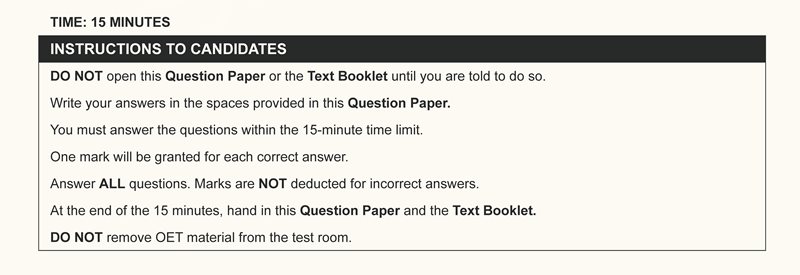
The text booklet contains your four texts, labelled A, B, C, D.
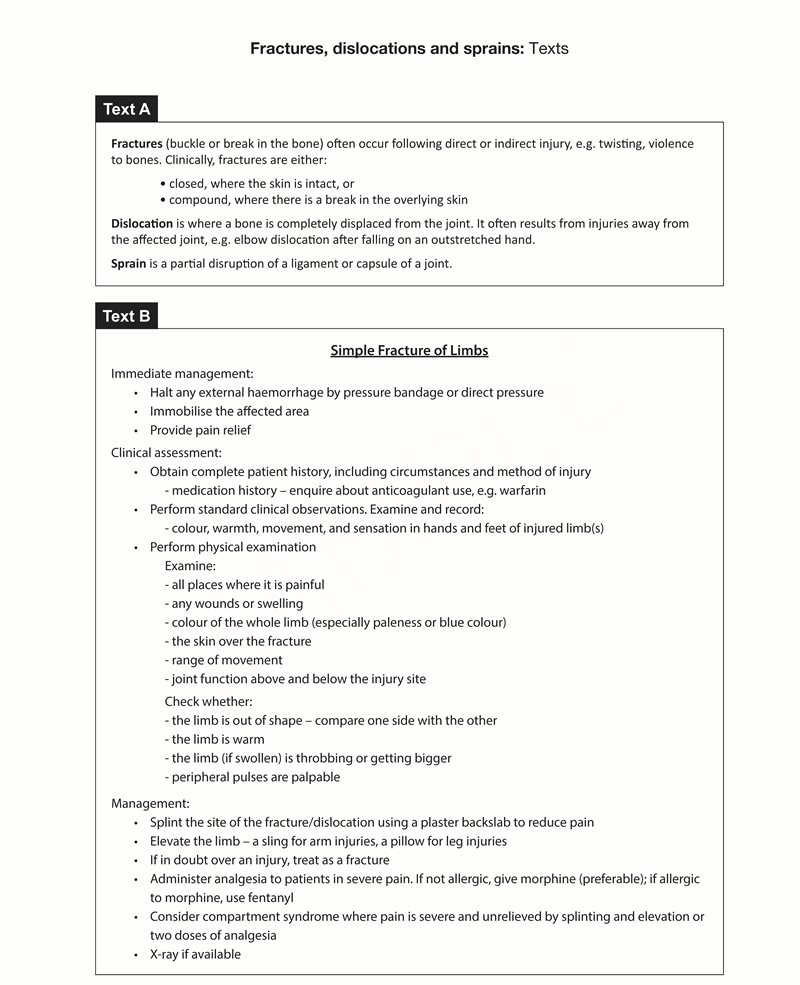
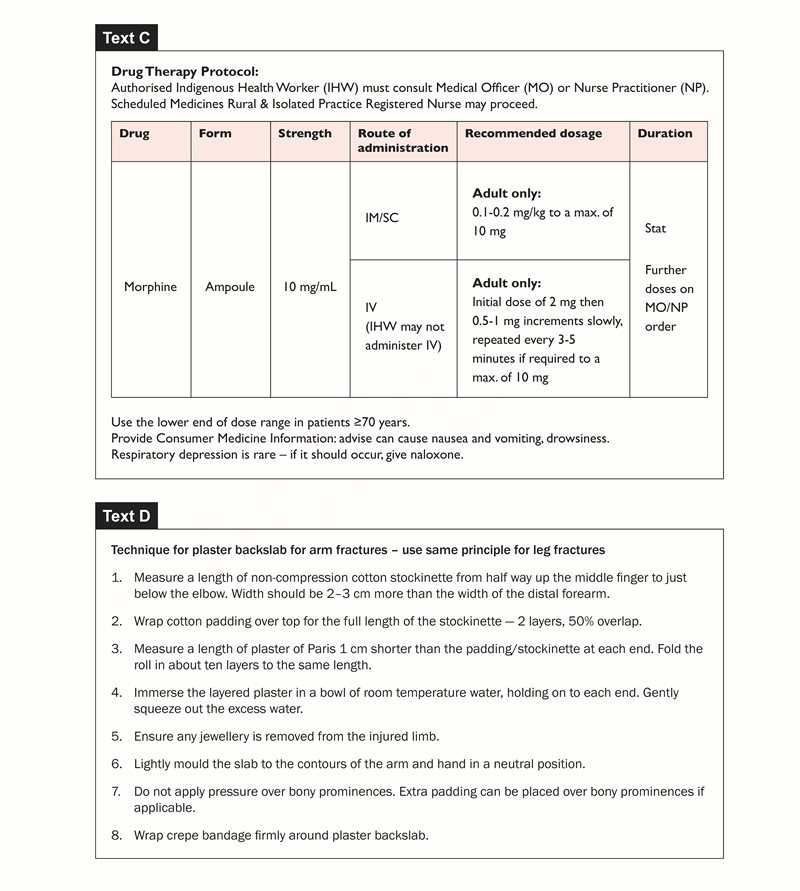
For OET on computer, your screen will be split so that your texts are on the left and your questions are on the right.
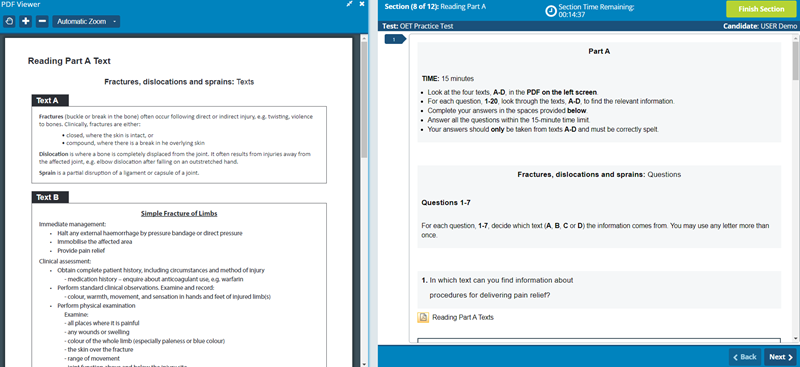
Screenshot of Reading Part A on computer
Before tackling the questions, it’s a good idea to quickly check the texts. You won’t have enough time to read them top to bottom, but you should find out what their purpose is, how they’re structured and how they differ from each other by skimming. To skim effectively, pay attention to the titles, introductory sentences if present, headings, sub-headings, bullet points and labels on visuals.
Matching questions:
The first set of questions is always matching questions and there are usually between 5 and 7 of them. For these questions, you need to decide which text (A, B C or D) each piece of information comes from. Your answer to each question will be one letter only. A B C or D.
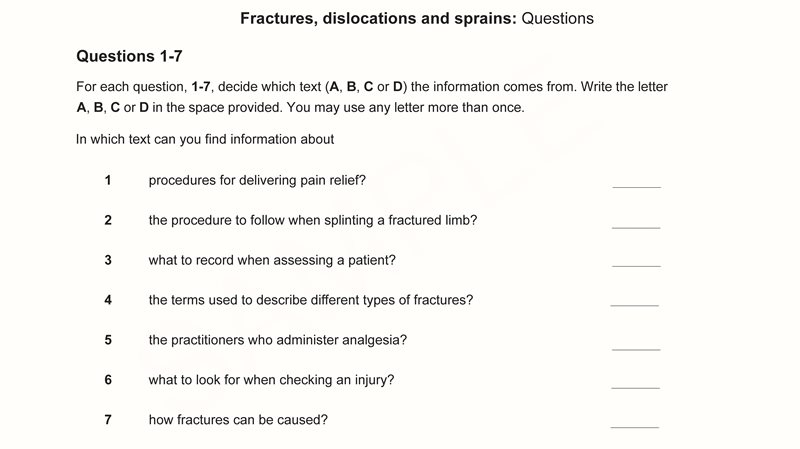
Reading Part A (OET on paper) matching questions
For instance, question 1 asks:
In which text can you find information about ‘procedures for delivering pain relief.’
Where is this information? When you find it, you simply write the letter, in this case, it’s from Text C so you’d write C in the space. For OET on computer, you select C with a left mouse click.
Keep in mind that C might also be an answer to other questions,(2-7). But each question will have one letter only as the answer.
Short answer questions:
The next set of questions will be either short answer or sentence completion. In this practice test, questions 8-14 are short answer questions. Here, you need to answer each of the questions with a word or short phrase from one of the texts. Each answer may include words, numbers or both. You should not write full sentences.
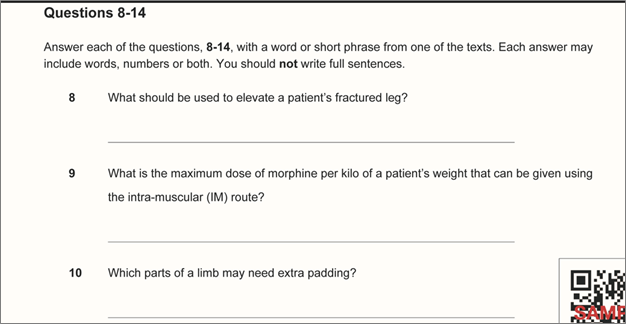
Reading Part A (OET on paper) short answer questions
Sentence completion questions:
Sentence completion questions work in a similar way. Again, you should read the sentence, locate the correct text and read carefully to find the exact answer to fill the gap.
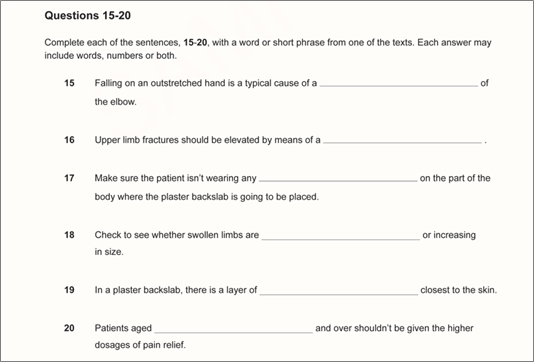
Reading Part A (OET on paper) sentence completion questions
Test tips:
Here are 5 tips to succeed in Part A.
1) Do the questions in order.
By starting with the matching questions, you will be better prepared to locate the answers for the rest of the questions because you will know what each is text is about, what its purpose is and who the audience is.
2) Copy exactly from the text.
For short answer and completion questions, you must copy the text exactly as its written into your answer spaces. If you make a spelling error or add words that aren’t needed, your answer will be marked wrong.
3) Keep your answers short.
Answers are usually between 1 and 3 words. Writing full sentences or including extra information will mean your answer is wrong.
4) Write clearly.
If you’re taking OET on paper, your Part A is marked by human assessors. If they cannot understand your writing, you will not get the point.
5) Manage your time.
There’s only 15 minutes for this part of the test, so you need to work quickly. Don’t spend too long on one question. If you’re struggling, have a guess, move on and come back to it later if you have time.
Watch this video to find out some common errors in Reading Part A and ensure you don’t make them! How to succeed in Reading Part A
Preparation recommendations:
To prepare for Part A, you need to practise expeditious reading, reading quickly and effectively. Here are some ways to work on this:
1) Practise skimming texts.
To do Part A well, you need to be able to get the idea of a text quickly without reading every single word. You can practise this by taking any kind of text and setting a timer for yourself. Skim the text by only reading titles, headings, subheadings, introductory sentences, bullet points and by using labels on visual information.
2) Practise scanning.
Another useful skill is scanning. This is when you look for a particular word or piece of information, again without actually reading. Think of it like the Control F function on your computer. You might be looking for a particular drug or an age group to answer a question. Use practice Listening tests with transcripts to work on this skill. Look at the question and scan the text to find the relevant place. The key to scanning is not to read, so try moving your eyes backwards through the transcript or up and down rather than left to right, which is how you would normally read. Another fun way to work on scanning is by doing wordsearches.
3) Start slow.
When you begin your Part A preparation, throw away the clock and focus instead on your skills and strategy. Make sure you know the instructions to the different tasks and how to answer the different question types. When you’re confident with how to tackle the questions, then you can start working on doing it faster.
Being able to locate information quickly and record it accurately is a key skill in the healthcare workplace and these are skills you will improve by preparing for OET Reading Part A.
Use the free sample tests or purchase extras in our Practice Books in the OET Store. And we have hours of free on-demand lessons on the OET YouTube channel.
Continue improving your reading skills for OET with these resources: